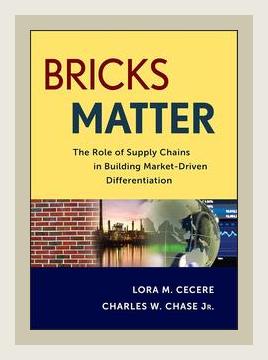Operations and Supply Chain ManagementSupply Chain Optimization
Title: Bricks Matter: The Role of Supply Chains in Building Market-Driven Differentiation
Author: Lora M. Cecere
Publication Year: 2012
Category: Supply Chain Optimization
Summary
1. Introduction to Market-Driven Supply Chains
Lora M. Cecere’s “Bricks Matter” underscores the critical role that supply chains play in creating market-driven differentiation for companies. The book begins by distinguishing traditional supply chains from market-driven ones, emphasizing the necessity for businesses to evolve and integrate customer insights into their supply chain strategies.
ACTION: Assess current supply chain operations to evaluate how well they integrate customer feedback and market intelligence.
Example: A major appliance manufacturer once solely focused on cost-efficiency in its supply chain. By shifting to a market-driven model, it began incorporating real-time customer feedback into its design and manufacturing processes, thus improving customer satisfaction and market relevance.
2. Evolution of Supply Chains
The book traces the evolution of supply chains from the 1980s to the present. Cecere points out that early supply chains were linear and function-focused (e.g., procurement, manufacturing, logistics), but modern supply chains require a more interconnected and holistic approach.
ACTION: Map out the supply chain processes within your organization, noticing areas where functions are siloed, and develop cross-functional teams to drive integration.
Example: Dell Computers’ customized approach in the 1990s broke the mold by integrating supply chain processes into a seamless operation from supplier to end customer, enabling rapid product customization and delivery.
3. The Hierarchy of Supply Chain Metrics
Cecere introduces a hierarchy of supply chain metrics that companies should follow: reliability, responsiveness, agility, cost, and asset management. These metrics form the foundational pillars for measuring the effectiveness of a supply chain.
ACTION: Develop a balanced scorecard for your supply chain that includes metrics from all five categories.
Example: A consumer goods company used these metrics to overhaul its supply chain, leading to a 25% reduction in delivery time and a 15% reduction in operational costs.
4. Building Supply Chain Resiliency
Resilience in supply chains is a recurring theme in the book. Cecere stresses the importance of building systems that can withstand disruptions, such as natural disasters or economic shifts. She provides strategies including diversification of the supplier base and implementation of risk management techniques.
ACTION: Create a risk management plan that includes supplier diversification, contingency plans, and regular stress tests for your supply chain.
Example: After the 2011 Japanese earthquake, Toyota re-evaluated its supply chain and increased its supplier base, significantly improving its resilience against future disruptions.
5. Supply Chain Talent Development
Cecere argues that building a skilled workforce is crucial for the success of any supply chain strategy. Companies should invest in training and developing their talent to handle increasingly complex supply chain networks.
ACTION: Implement a continuous learning program focused on supply chain management skills and knowledge within your organization.
Example: Procter & Gamble redefined its approach to talent by creating specialized training programs that significantly improved decision-making and operational efficiency within its supply chain teams.
6. Technology Integration
The role of technology, including big data, cloud computing, and the Internet of Things (IoT), is highlighted as essential for modern supply chains. Cecere suggests leveraging technology to improve visibility, streamline operations, and enhance decision-making.
ACTION: Conduct an audit of current technology usage in your supply chain and identify areas where technological innovations can be integrated to improve efficiency and transparency.
Example: Caterpillar, through IoT integration, achieved better predictability in equipment maintenance, reducing downtime and operational costs.
7. Customer-Centric Design
Cecere emphasizes designing supply chains with the customer at the center. This involves not only meeting current customer needs but also anticipating future demands through robust market analysis and trend forecasting.
ACTION: Create a customer advisory board to provide continuous feedback and use this data to refine supply chain practices.
Example: Starbucks employs customer data from its loyalty programs to predict purchasing patterns and optimize inventory management in its supply chain.
8. Collaboration and Partnerships
Strategic collaboration with partners is vital for a successful supply chain. Cecere points out that building a strong network of suppliers, manufacturers, and logistics providers can drive innovation and efficiency.
ACTION: Develop collaborative agreements with key partners to align goals and create shared value.
Example: The partnership between Unilever and its logistics providers to create more sustainable transportation solutions resulted in significant environmental benefits and cost savings.
9. Sustainability and Ethical Practices
Sustainability and ethical practices in supply chains are not just about compliance but can also lead to competitive differentiation. Cecere recommends going beyond regulatory requirements to imbue ethical practices across the supply chain.
ACTION: Initiate a green supply chain program that focuses on reducing carbon footprints, waste, and ethical sourcing.
Example: IKEA’s implementation of a sustainable sourcing policy not only improved its brand image but also ensured long-term cost savings through better resource management.
10. Innovation and Continuous Improvement
The book concludes with a focus on the necessity for continuous improvement and innovation within supply chains. Cecere advises creating an organizational culture that values experimentation and incremental improvements.
ACTION: Establish a continuous improvement team dedicated to identifying areas for innovation and implementing pilot projects.
Example: 3M’s culture of continuous improvement and innovation has allowed it to stay ahead in multiple industries, leveraging its supply chain for rapid product development and market introduction.
Conclusion
“Bricks Matter” offers a comprehensive guide to transforming supply chains into strategic assets that drive market differentiation. By focusing on key areas such as resiliency, technological integration, customer-centricity, collaboration, sustainability, and continuous improvement, Cecere provides both the conceptual framework and practical actions required for optimizing supply chains. Companies that embrace these strategies can not only enhance their operational efficiency but also achieve lasting competitive advantage.
Operations and Supply Chain ManagementSupply Chain Optimization
